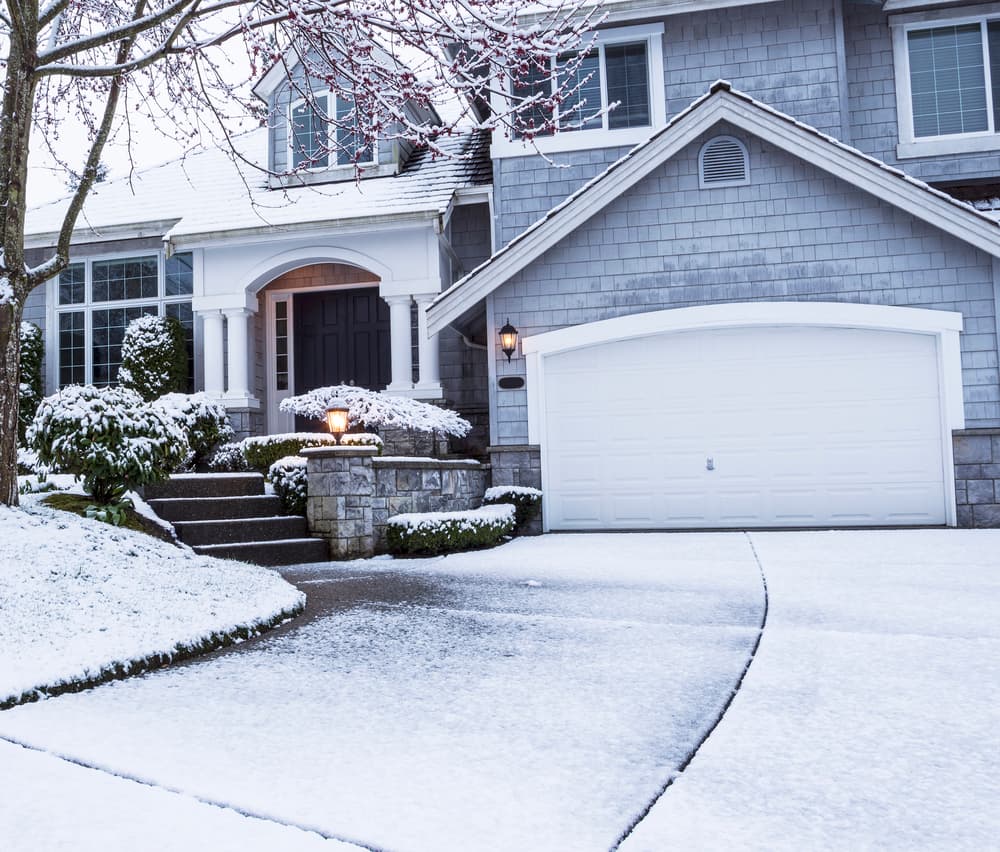How To Protect Your Outdoor Staircase in the Winter
By Léa Plourde-Archer
Updated on November 7, 2023

Winters in Canada are long, gruelling and freezing cold. Living in this country, you quickly discover ways to adapt to sub-zero temperatures: you purchase a down-filled, well-built jacket alongside some heavy-duty boots, you dress in layers and make sure little to no skin is exposed.
However, how do you protect the outside of your home from this harsh weather? Unfortunately, it's not as simple as throwing a jacket onto your facade and hoping for the best. We require ways to protect the outdoor parts of our home from the elements. One of the home's most important extremities is the front steps. We use our steps every day, and run the risk of ice buildup, causing damage to the material and potentially putting us in danger.
Protect your outdoor staircase from the cold Northern climate
Clean & Repair the Front Steps

Make sure that before the winter swings into full gear, your front steps have been thoroughly cleaned. If you've forgotten to do so and the snow sneaks up on you, try and give them a good scrub on warmer days when there isn't an abundance of snow (or any at all!). If you find any oil or grease stains, it is important to remove them before weatherproofing!
When cleaning, make sure to check the steps for any form of deterioration, splintering, insect damage or cracks and repair immediately if found. If you don't tend to any issues you discover before winter sets in, the damage could easily come back two-fold following the season. Also, some of the harsher ice-protecting products will aid in the degradation of the materials.
Use a Protective Stain
If you are concerned that the weather will damage the material of your front steps, use a protective stain on them. Without renewed protection, your steps will start to decay as water from the snow and ice will rot the boards and compromise the structure. Specifically, if your front steps are made of wood, it is necessary to safeguard the wood against cold weather and water.
This process can be done in one of two ways. Firstly, you can use paint, which will seal the wood under a protective film. Otherwise, if you'd like to stick to the original colour and enhance the grain, you can stain your steps with a water-resistant stain. There are many different types of stains which offer to protect from the elements.
However, water-seal natural wood protecting stains will seal the wood without causing it to shrink, crack or rot. These stains generally contain silicone or wax, causing water to bead off the surfaces where they've been used. Water seal stains prevent the surfaces from being slippery, adding an element of safety to both the wood and the homeowner.
Salt and Serious Ice Melters

Source: MaxPixel, Creative Commons
There is a lot of debate surrounding which method is best to protect your front steps from winter wear, keeping these surfaces safe for yourself and visitors. First off, using a shovel is a secure way to remove the immediate layer of snow and ice from your steps without damaging the masonry of the building. However, during a Canadian winter, this is usually not enough and further methods of ice removal are necessary.
Rock salt, or sodium chloride, is the most frequently used ice-melting method, but can, unfortunately, cause a great deal of damage to your front steps as well as the surrounding facade as it releases a high amount of chloride when dissolved.
Another form of salt is calcium chloride or de-icing salt. This salt can cause skin irritation and although not as harsh as rock salt, can corrode concrete. Make sure to watch for products containing ammonium nitrate or ammonium sulphate, as these two elements will break down even the most durable of materials.
When salt meets concrete, it causes it to pit, crack and eventually form potholes in the surface. When it meets metal, salt causes corrosion. It also pollutes water sources, so whenever possible, avoid this method.
However, if you or your neighbours are still salting. there are salt guard products on the market that can be sprayed onto steps before or during the winter months to protect them from both the component as well as the harsh elements. After the surfaces have been cleaned or repaired, spray an application of salt guard, which will also stop water from soaking in and protect against corrosion.

Gravel and Sand
Sand is another common way to protect steps from ice buildup and is a pet-friendly option for those with little critters whose paws are extremely susceptible to breakage from ice and salt. Sand will provide traction on your front steps without causing harm to the material underneath.
Although sand can end up embedding itself into wood, it is one of the softer methods on outdoors materials. Unfortunately, sand and gravel do not really melt the ice and can be fairly messy when tracked in and out of the house. However, the mess is a small price to pay to keep yourself and your family safe, as well as the facade of your home.
Heated Outdoor Stairs
Since your slippery outdoor steps are a liability, and many homeowners can't be bothered with the constant hassle of salting everytime the snow falls, a new trend has emerged. Heated stair mats can be placed on your steps to safely melt ice and prevent slipping. Heated mats do not cause any danger to surfaces as they are chemical free.
However, surfaces that are heated unevenly are vulnerable to cracking and spalling. If your surfaces are even and clean before using the pads, they will maintain their appearance following the winter months. The cost of snowmelt systems will vary depending on the brand, and the pads themselves become damaged, making them difficult to repair. However, if you are looking to try a new method this winter, there are several options on the market.
Here are some articles that might interest you:
Get 3 renovation quotes for your outdoor staircase renovation project
RenoQuotes.com can help you get quotes for your outdoor staircase renovation, maintenance or protection. If you submit your project to us, we’ll put you in contact with 3 qualified professionals. Fill out the form on our homepage (it only takes a few minutes), and you will receive quotes from trusted renovation specialists.
Dial 1-844 828-1588 to speak with one of our customer service representatives
Looking for something else?
Related articles
The latest industry news, interviews, technologies, and resources.

Amanda Harvey
•07 Nov 2023
Being subjected to a house fire certainly brings its share of sadness and concern. Whether we’re thinking of lost memories or the work that’s required to restore our home, as well as the expenses that’ll necessarily accompany it, this is not a time of celebration.

Léa Plourde-Archer
•06 Nov 2024
At first glance, the role of a general contractor can seem vague. Acting as a conductor of sorts for home renovation projects, general contractors are responsible for ensuring the successful completion of the project, making sure that the whole process runs smoothly.
Léa Plourde-Archer
•20 Dec 2024
Purely aesthetic or essential, done on a whim or carefully thought out, interior home renovations meet a variety of needs and wants. Where should you start an interior home improvement project? What types of projects balance style and functionality the best? How can you find ideas customized to your space?

Editorial Team
•14 Nov 2023
Have you finally decided to start a full or partial home renovation to boost your comfort and living space or simply revamp your outdated home?

Editorial Team
•26 Sep 2024
If you own a cottage and go there several times per year or per season, you may be considering taking on some renovations. Even if it was recently built, it’s never unnecessary or too late to add value to your property.